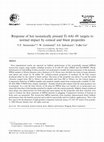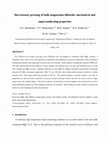Papers by sastry S. Indrakanti
Fundamental Issues and Applications of Shock-Wave and High-Strain-Rate Phenomena, 2001
Materials Today: Proceedings
Fundamental Issues and Applications of Shock-Wave and High-Strain-Rate Phenomena, 2001
Fundamental Issues and Applications of Shock-Wave and High-Strain-Rate Phenomena, 2001
Key Engineering Materials, 2000
Hot isostatically pressed (HIPed) Ti-6Al-4V powder based targets (including composites) have a go... more Hot isostatically pressed (HIPed) Ti-6Al-4V powder based targets (including composites) have a good ballistic performance against long rod, conical and flat projectiles impact (velocity range approx 0.4 - 1km/s). Compared to baseline material (MIL-T-9047G), new features such as different shape of craters in long rod penetration tests were observed. The results of compression Hopkinson bar tests, cut from tested targets (final strain controlled tests and hat-shaped specimen tests) are presented with a goal to establish relations between ballistic performance and high strain rate properties of HIPed materials.

International Journal of Impact Engineering, 2003
First experimental results are reported on ballistic performance of hot isostatically pressed (HI... more First experimental results are reported on ballistic performance of hot isostatically pressed (HIPed) texture-free targets using rapidly solidified powders of Ti-6Al-4V alloy (PREP and ELI-PREP). Plastic deformation by ball milling of these powders was performed to modify the microstructure of the materials. HIPed samples of 40 mm diameter and a thickness of 10-30 mm were shrinkfit into holes in larger diameter steel plates and struck by 50 caliber 601 cylindro-conical projectiles of hardness R c 60 with contact produced either by the conical or blunt surface. The mass of the projectile was about 31 g and the initial velocities ranged from 300 to 450 m/s for flat-ended and from 900 to 950 m/s for the conical impacts. Comparative behavior of HIPed samples and standard samples made from commercially available Ti-6Al-4V alloy MIL-T-9047G (bar, forged, annealed)-baseline material after impact with the same geometry was investigated. As a rule the final velocity of the plug for HIPed alloy was smaller (or no penetration was observed) than that of the baseline material for impact with the conical projectile. Slightly sloped cylindrical shear plugs were characteristic for both materials upon impact by flat projectiles and their velocities were used to evaluate the shear resistance of HIPed material to plugging. Comparative features of fracture in both cases are presented. The texture-free HIPed materials from powders demonstrated better ballistic performance than the baseline material and could be successfully used for ballistic applications. This is the first step in the development of high-gradient composite materials using a Ti-6Al-4V matrix from powder. r

Metals and Materials International, 1998
Hot Isostatic Pressing (HIP) of powders was modeled by Arzt, Ashby and Easterling (AAE model) and... more Hot Isostatic Pressing (HIP) of powders was modeled by Arzt, Ashby and Easterling (AAE model) and hot-isostatic diagrams were constructed based on several mechanisms: plastic yielding, power-law creep, diffusional densification, which can also include grain growth and pore separation. AAE model matches power-law creep solution and elastic solution to obtain an important coefficient. In this paper, a modified way to derive the densification rate equation during the stage of the power-law creep is proposed. The HIP diagrams constructed using AAE model, the modified model and the model introduced by Gampala et. al., are applied to HIPing of Ti-6A1-4V powders. The modified approach provided slower densification during initial stage of consolidation in comparison with other models. These approaches converge when full density is being achieved. Comparison with experiment is discussed.

Two different hot isostatic pressing cycles (HIPing) were investigated to synthesize bulk MgB2 sa... more Two different hot isostatic pressing cycles (HIPing) were investigated to synthesize bulk MgB2 samples: a "standard" cycle where a low vessel pressure is maintained while heating to the process temperature with a subsequent simultaneous pressure and temperature decrease and a new method - dense material cooling under pressure (DMCUP). The latter method allowed the synthesis of dense samples with diameters up to 20 mm and thicknesses up to 10 mm from commercial MgB2 powder. Optimal conditions for the DMCUP method with glass encapsulation (maximum pressure 200 MPa, maximum temperature 1000 C over 200 min, and cooling under pressure) resulted in a dense material with a sharp superconducting transition at 38.5 K. This method employs a pressure which is one order of magnitude less than previously reported for pressure assisted sintering of dense material and can be scaled to larger sample sizes and complex shapes. The data for density, microhardness, fracture toughness and sound speed as well as superconducting properties for bulk magnesium diboride are presented. Ball milling the powder enhances sintering and results in a more homogeneous final microstructure.
We studied the influence of sample preparation and defects in the superconducting properties samp... more We studied the influence of sample preparation and defects in the superconducting properties samples using atomic ratios of Mg:B=1:1 and Mg:B=1:2. Samples were characterized by SEM, and XRD, and the magnetization properties were examined in a SQUID magnetometer. The presence of Mg vacancies was determined by Rietveld analysis. Most of the samples exhibited sharp superconducting transitions with Tcs between 37-39 K.

Mechanics of Materials, 2001
This paper presents the results of a systematic comparative study of the dynamic thermomechanical... more This paper presents the results of a systematic comparative study of the dynamic thermomechanical response of Ti± 6Al±4V alloys with three dierent microstructures. Two of the alloys are produced by the hot isostatically pressed technique using rapidly solidi®ed granules, with one alloy milled prior to hot pressing. Experiments are performed over a broad range of strain rates, 10 À3 ±7000 s À1 , and initial temperatures, 77±1000 K. Depending on the test temperature, compressive strains of 10±60% are achieved. The microstructure of the undeformed and deformed specimens is investigated, using optical microscopy. The dependence of the¯ow stress on the temperature and the strain rate is examined for various strains and it is related to the corresponding material microstructure. The results show that adiabatic shearbands develop at high strain rates, as well as at low strain rates and high temperatures. Depending on the test temperature, shearbands initiate once a sample is deformed to suitably large strains. The¯ow stress is more sensitive to temperature than to the strain rate. Based on these results and other published work, the thermally activated mechanisms associated with the dislocation motion are identi®ed. The physically based model proposed by for OFHC copper, is suitably modi®ed and applied to this class of titanium alloys. In the absence of dynamic strain aging, the model predictions are in good accord with the experimental results. Comparing the results for the three considered Ti±6Al±4V alloys, with dierent microstructures, it is found that the initial microstructural features aect only the magnitude of the threshold stress and the athermal part of the¯ow stress, but not the functional dependence of the thermally activated part of the¯ow stress on the temperature and the strain rate. Ó
Hot Isostatic Pressing (HIP) is one of the most efficient techniques to produce high quality mate... more Hot Isostatic Pressing (HIP) is one of the most efficient techniques to produce high quality materials from powders. Nevertheless there is a shortage of data on high-strain-rate behavior and penetration resistance of such materials. In this paper the results of penetration test with tungsten (93%) heavy alloy penetrators of solid and porous composite samples of Ti-6Al-4V alloy with different microstructures (Widmanstatten pattern and equiaxed) are presented. Penetration depth for HIPed materials is smaller than in baseline samples of Ti-6Al-4V alloy (forged rod MIL-T-9047G). Composite materials with alumina rods and tubes filled with B4C powders demonstrated a new features of penetration: projectile deflection with self sealing of hole and forced shear localization caused by tubes fracture. The results demonstrate the applicability of HIPing for Ti-based armor materials. .
Under the influence of the gradual addition of point disorder induced by proton irradiation, the ... more Under the influence of the gradual addition of point disorder induced by proton irradiation, the first order melting transition of the flux line lattice in YBa_2Cu_3O_7-δ evolves into a continuous transition.(L. M. Paulius et al.), Phys. Rev. B 61, R11913 (2000). In this study we investigate the flux line lattice melting phenomenon by means of electrical resistivity ρ(T) measurements in twinned Y_1-xPr_xBa_2Cu_3O_7-δ single crystals to study the effect of Pr-impurities on the melting transition. These high quality single crystals were grown in BaZrO3 crucibles, which were prepared by cold isostatic pressing, sintering, and HIPing. We also observed that dc, ac, and step function-like transport current resulted in different features in ρ(T) near the melting temperature, revealing metastable characteristics of the flux line ensemble in the vicinity of the melting transition.

Electric field vs. current density (E-J) isotherms in the mixed-state of a bulk sample of the hig... more Electric field vs. current density (E-J) isotherms in the mixed-state of a bulk sample of the high-temperature superconductor MgB2 (Tc = 38.5 K) synthesized under 200 MPa pressure by hot isostatic pressing (HIPing), have been measured and analyzed in terms of the critical scaling model. The samples are fully dense and display excellent superconducting properties, including a narrow superconducting transition width (ΔTc = 0.75 K), a high upper critical field H_c2 (H_c2(0) ~ 155 kOe), and a critical current density J_c(0) ~ 1.4 MA/cm^2. E-J isotherm sets at fields ranging from 2 to 90 kOe conform to the vortex-glass universal scaling anzatz. Scaling and resistivity data suggest the existence of a Bragg glass state for H <= 8 kOe. The critical scaling exponents show weak field dependences, with ν ~ 0.6 - 0.9 and z ~ 3.1 - 3.4. A more complete phase diagram (H-T), containing the upper critical field H_c2(T), the vortex-glass transition line H_g(T), and the magnetic irreversibility line H_irr(T) has been established for bulk MgB_2. Both H_g(T) and H_irr(T) follow a |1-T/T_g|^n dependence with n = 1.32 and n = 1.5, respectively, similar to values obtained for high-Tc cuprate superconductors.

The superconductivities of samples prepared by several procedures were found to degrade under amb... more The superconductivities of samples prepared by several procedures were found to degrade under ambient environment. The degradation mechanism was studied by measuring the change of surface chemical composition of dense MgB 2 pellets (prepared by hot isostatic pressure, HIPed) under atmospheric exposure using X-ray Photoelectron Spectroscopy (XPS). Results showed that samples with poor connectivity between grains and with smaller grain sizes degrade with time when exposed to ambient conditions. In these samples, the Tc did not change with time, but the superconducting transition became broader and the Meissner fraction decreased. In contrast, our well-sintered and the HIPed samples remained stable for several months under ambient condition. The degradation was found to be related to surface decomposition as observed by XPS. We observed the formation of oxidized Mg, primarily in the form of a Mg hydroxide, the increase of C and O contents, and the reduction of B concentration in the surface layer of MgB 2 samples.

Hot Isostatic Pressing (HIP) is one of the most efficient techniques to produce materials from po... more Hot Isostatic Pressing (HIP) is one of the most efficient techniques to produce materials from powders. Nevertheless there is a shortage of data on high-strain-rate behavior and penetration resistance of such materials. In this paper the results of penetration test (tungsten rod, velocity 886-960 m/s, diameter D=4.98 mm, L/D=10) with solid and porous composite samples of Ti-6Al-4V alloy with different microstructures (Widmanstatten pattern and equiaxed) will be reported. Milling of rapidly solidified Ti-6Al-4V powders prior to HIPing ensured the equiaxed final microstructure with increased compressive yield strength and microhardness (1180 and 3370 MPa correspondingly). Interstitial content was suitable for armor applications in some of the processing routes. Penetration depth for HIPed materials(14-15 mm) is smaller than in baseline samples of Ti-6Al-4V alloy (forged rod MIL-T-9047G). The results demonstrate the applicability of HIPing for Ti-based composite armor materials.
The thermal expansion coefficient α of MgB2 is observed to change from positive to negative upon ... more The thermal expansion coefficient α of MgB2 is observed to change from positive to negative upon cooling through the superconducting transition temperature Tc. The bulk Grüneisen parameter, which is proportional to α, changes sign at Tc as well. The jumps in α and the heat capacity at Tc are used to estimate its pressure dependence, dTc/dP; comparison to the measured value reveals violation of the Ehrenfest relation by 42%. The results suggest anomalous coupling between the lattice and superconducting electrons via low-energy phonons.

Good ballistic performance with long rod, conical and flat projectiles (velocity range 0.4 - 1km/... more Good ballistic performance with long rod, conical and flat projectiles (velocity range 0.4 - 1km/s) of hot isostatically pressed (HIPed) Ti-6Al-4V powder based targets (including composites) was demonstrated in our previous work. Compared to baseline material (MIL-T-9047G), new features such as different shape of craters in long rod penetration tests, etc were observed. In addition, there is a large spread of the plug velocities of HIPed materials in some flat projectile penetration experiments. The results of compression Hopkinson bar tests, final strain controlled and hat-shaped specimen tests on material cut from impacted targets will be presented to establish relations between ballistic performance and high strain rate properties of HIPed materials. The different microstructures of shear induced fracture surfaces in samples with different ballistic performance will be discussed to explore the correlation between ballistic properties and fracture behavior.
Hot isostatic pressing with glass encapsulation (pressure, 200 MPa; temperature, 1000°C over 200 ... more Hot isostatic pressing with glass encapsulation (pressure, 200 MPa; temperature, 1000°C over 200 min; cooling under pressure) was used to synthesize bulk MgB 2 with diameters up to 20 mm and thicknesses up to 10 mm from MgB 2 powder. A sharp superconducting transition was measured at 38.5 K. This method can be scaled to larger sample sizes and complex shapes. The data for density, microhardness, fracture toughness and sound speed for bulk magnesium diboride are presented. Ball milling the powder results in a more homogeneous ®nal microstructure with a higher resistivity and with a similar superconducting transition.








Uploads
Papers by sastry S. Indrakanti